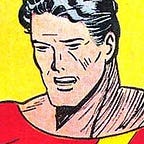Grant Morrison’s unrealized vision for ‘Nick Fury, Agent of S.H.I.E.L.D.’
In 2002, writer Grant Morrison pitched an ongoing series to Marvel Comics, featuring the publisher’s iconic super-spy character, Nick Fury. While this series never materialized, a twelve-page short story published in Marvel Knights: Double Shot #2 (July 2002) offers insight into what Morrison may have had in mind for the character.
The story “Nick’s World” (illustrated by Manuel Gutierrez with colors by Jeromy Cox) takes advantage of the creative experimentation allowed by the Marvel Knights imprint, presenting a fast-paced story that challenges readers’ perceptions of Fury. Morrison eschews conventional glamorous portrayals of the character, depicting Fury changing a flat tire and chatting with his comely female companion about his bowel movements.
This is Nick Fury? Well, it turns out, no, it isn’t — the whole scene is a virtual reality test simulation for nefarious secret agent Chris Kong, who schemes to assume Fury’s identity and replace him as leader of the global spy organization SHIELD in order to sow chaos.
But in every simulation — even with assistance from strange, alien benefactors — Kong fails at replacing Fury, although Kong commits everything to the role, including sacrificing an eye to match Fury’s missing left eye.
Morrison’s story elements — virtual reality and Kong’s efforts to steal Fury’s identity — are reminiscent of acclaimed artist/writer Jim Steranko’s use of misdirection in presenting the character. For example, in “Today Earth Died!” (Strange Tales #168; May 1968) readers see Fury fail to save the Earth, only to discover that the whole adventure is a dream (or is it?), while in “Who is Scorpio?” (Nick Fury, Agent of S.H.I.E.L.D. #1; June 1968), readers see Fury get shot, only to discover that the person who shot Fury is, in fact, Nick Fury, and that the fallen spy is actually a “Life Model Decoy” robot built to resemble Fury.
Morrison uses narrative misdirection not only to pay homage to Steranko’s past work, but to create an ambivalence in readers towards Fury. When the real Fury appears in the story to confront Kong, his actions are so extreme — so darkly silly — that Morrison risks making Kong a sympathetic figure. Even one of Fury’s colleagues remarks, “You went to a whole lot of trouble for one guy, Colonel Fury”, to which Fury responds, in a flippant machismo manner, “This is the free world we’re talking about, baby. Somebody’s gotta take care of the details.”
Indeed, Morrison’s story both celebrates and lampoons Fury. While the speed and strangeness of Fury’s lifestyle is presented as cool, the over-the-top machinations of both Kong and Fury, the bizarre virtual reality representations of Fury’s adventures, and the scatological humor all undercut the potential threat presented in the narrative, giving the whole story a whimsical quality.
Examining Mark Millar’s work on Marvel’s The Ultimates series (which also debuted in 2002, and also features Nick Fury, drawn to resemble actor Samuel L. Jackson) in his book Supergods, Morrison observes:
“Marvel stepped into the post-9/11 breach with global-political thrillers that acknowledged contemporary events without dwelling on them. The Ultimates, re-created with Mark Millar’s gleefully right-leaning heroes, gave a voice to Bush’s America’s posturing, superheroic fantasies of global law enforcement in a posttraumatic world. It was both a glorification and a satire of those attitudes, and Millar was savvy enough to maintain the ambiguity to the end.”
Judging from his “Nick’s World” story, had Morrison convinced Marvel to publish a Nick Fury series, his plans for Fury may have turned the hero into an ambiguous character having fast and fun (but also satirical) adventures, making — like Millar’s Ultimates — a sly commentary on America’s post-9/11 political and military power.
NOTES: The blog Deep Space Transmissions lists Morrison’s unpublished Marvel work, including Nick Fury, Agent of S.H.I.E.L.D.
Morrison analyzes Millar’s The Ultimates and his own post-9/11 Marvel work in Chapter 22 (“Nu Marvel 9/11”) of Supergods.
The full credits for “Nick’s World” follow: Grant Morrison, story; Manuel Gutierrez, art; Avalon’s Jeromy Cox, color; RS & Comicraft’s Wes, letters; Stuart Moore, Editor; Nanci Dakesian, Managing Editor, Kelly Lamy, Associate Managing Editor; Joe Quesada, Editor In Chief; Bill Jemas, President.
The images above are the property of their respective owner(s), and are used here for nonprofit educational purposes only.
